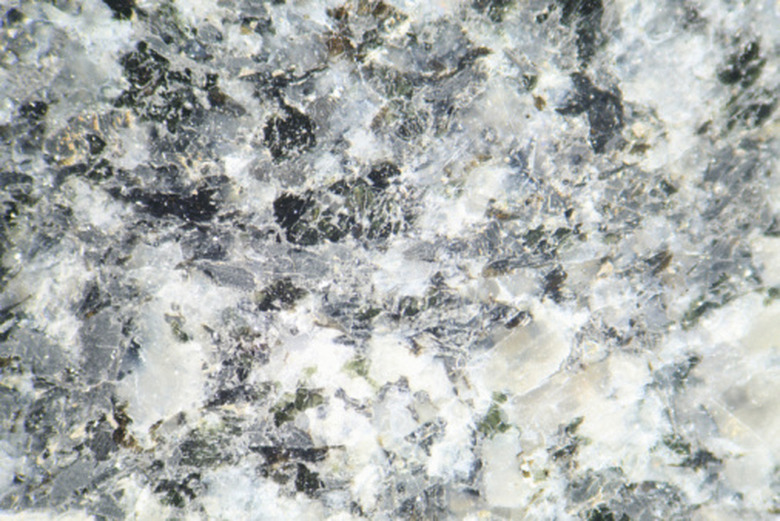Types Of Intrusive Igneous Rock With Large Crystals
Intrusive igneous rock is formed from magma that cools beneath the surface of the Earth. This cooling process takes a very long time, on a scale of thousands or millions of years and produces a matrix of mineral crystal grains. This crystalline structure is large enough to be seen with the naked eye. There are five primary types of intrusive igneous rocks with these large crystals: granite, pegmatite, diorite, gabbro and peridotite.
Granite Rock
Granite Rock
Granite rocks are classified as felsic, or sialic, igneous rock. They are light-colored rocks, with coarse grains. These rocks, which are primarily formed from continental crust, are high in silica content. The primary minerals found in granite rocks, which are responsible for forming the crystals, include:
- potassium-plagioclase feldspar
- sodium-plagioclase feldspar
- quartz
- biotite
The potassium-plagioclase feldspar is what gives some granites their pink color. Other minerals that may be present in a piece of granite include amphibole and muscovite.
Pegmatite Rock
Pegmatite Rock
Pegmatite rocks are also classified as felsic, or sialic, igneous rock. They are light-colored rocks, with extremely coarse grains. Pegmatite rock is primarily formed from continental crust and is also high in silica content. These rocks are typically formed on the outer edges of magma chambers, during the final stage of crystallization. While similar in overall composition to granite, pegmatite rocks often contain rare minerals that are not found in the rest of the magma chamber.
Diorite Rock
Diorite Rock
Diorite rocks are classified as intermediate igneous rock. These rocks have a composition that lies between the felsic rocks, such as granite, and mafic rocks, such as gabbro. Diorite is a relatively rare rock that is gray or dark-gray in color, with coarse grains. The mineral composition is primarily composed of sodium-plagioclase feldspar, calcium-plagioclase feldspar and amphibole. Smaller amounts of proxene, biotite and quarts may also be found in diorite.
Gabbro Rock
Gabbro Rock
Gabbro rocks are classified as mafic igneous rock. These rocks are dark in color, with coarse grains. These rocks, which are primarily formed from oceanic crust, are high in ferromagnesian content. In addition to these iron silicates and magnesium, gabbro primary mineral content includes calcium-plagioclase feldspar and pyroxene. Smaller amounts of olivine and amphibole may also be found within gabbro.
Peridotite Rock
Peridotite Rock
Peridotite rocks are classified as ultramafic igneous rock, being almost entirely ferromagnesian in nature. These rocks are dark in color, with coarse grains. Peridotite is believed to be a major component of the Earth's mantle due to an extremely high melting point. As a result, peridotite is rarely found on the planet's surface. In terms of mineral content, peridotite is almost exclusively comprised of olivine. This mineral gives the rock its olive-green color. Trace amounts of pyroxene may also be found in peridotite. The Peridot birthstone is produced from peridotite rock.
Cite This Article
MLA
Bennett, Doug. "Types Of Intrusive Igneous Rock With Large Crystals" sciencing.com, https://www.sciencing.com/types-igneous-rock-large-crystals-8350141/. 24 April 2017.
APA
Bennett, Doug. (2017, April 24). Types Of Intrusive Igneous Rock With Large Crystals. sciencing.com. Retrieved from https://www.sciencing.com/types-igneous-rock-large-crystals-8350141/
Chicago
Bennett, Doug. Types Of Intrusive Igneous Rock With Large Crystals last modified March 24, 2022. https://www.sciencing.com/types-igneous-rock-large-crystals-8350141/
